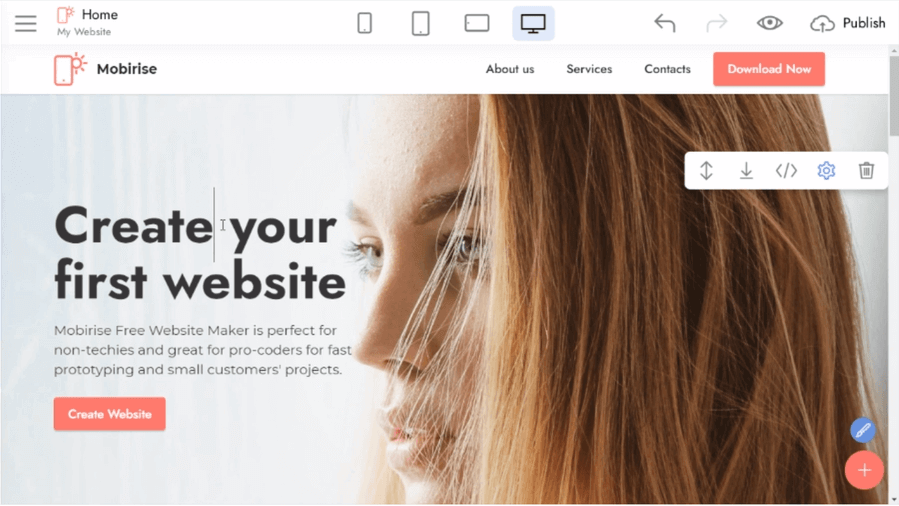
How to Create Your Own Blog Website with SEO (No Coding Required!)
Ever wanted to share your passions, insights, or expertise with the world? A blog is the perfect platform! And the good news is, you don’t need to be a coding genius or a tech expert to build a professional-looking and SEO-friendly blog.
Just like the image suggests, tools are available that empower you to create a stunning online presence with ease. Let’s dive into how you can create your very own blog website, complete with essential SEO elements, without breaking a sweat (or any rules!).
Step 1: Choose Your Website Builder (and Why Simplicity is Key)
The image you shared prominently features “Mobirise Free Website Maker.” While there are many website builders out there, the key is to choose one that is user-friendly and allows for drag-and-drop customization.
Popular and beginner-friendly options include:
- Mobirise: As seen in the image, this is a desktop application that helps you build responsive, mobile-friendly websites. It’s great for visual design and offers a lot of pre-made blocks.
- WordPress.com: A fantastic option specifically designed for blogging. It offers a lot of themes and plugins (some free, some paid) that can enhance your blog’s functionality and SEO.
- Wix: Another popular choice known for its intuitive drag-and-drop interface and vast template library.
- Squarespace: Offers beautiful, modern templates and is known for its strong design focus.
Why choose a website builder? - No coding required: Focus on your content, not complex code.
- Drag-and-drop interface: Easily arrange elements like text, images, and videos.
- Pre-designed templates: Get a professional look in minutes.
- Mobile-responsive designs: Your blog will look great on any device.
Step 2: Plan Your Blog’s Structure and Content
Before you even touch a website builder, it’s crucial to plan your blog’s structure and the type of content you want to publish. - Niche/Topic: What will your blog be about? Be specific!
- Categories: How will you organize your posts? (e.g., “Recipes,” “Travel Tips,” “Product Reviews”).
- Key Pages: Beyond your blog posts, what other pages do you need? (e.g., “About Us,” “Contact,” “Privacy Policy”).
- Keywords: Start thinking about the words and phrases people might use to find your content on search engines.
Step 3: Design Your Blog (Inspired by the Image!)
The image shows a clean, modern layout with a prominent hero section and clear call to action. You can achieve a similar aesthetic with most website builders. - Homepage: Make a strong first impression.
- Headline: Craft a compelling headline that tells visitors what your blog is about (e.g., “Create Your First Website” from the image).
- Sub-headline/Description: Provide a brief overview of your blog’s purpose.
- Call to Action (CTA): Encourage visitors to read your latest post, subscribe, or explore your content (e.g., “Create Website” button).
- Navigation: Keep it simple and clear. Include links to your “Home,” “About Us,” “Services” (if applicable), and “Contacts” pages, as seen in the image.
- Visuals: Use high-quality images and videos that are relevant to your content.
- Branding: Choose consistent colors, fonts, and a logo (even a simple text-based one) to establish your brand identity.
Step 4: Implement Basic SEO (Search Engine Optimization)
This is where you make your blog discoverable on Google and other search engines. You don’t need to be an SEO expert, but these fundamental steps are crucial: - Keyword Research (Simplified): Think like your audience. If you’re writing about “healthy breakfast recipes,” what phrases would someone type into Google to find that? Use tools like Google Keyword Planner (free with a Google account) or simply Google’s autocomplete suggestions to find relevant keywords.
- On-Page SEO for Blog Posts:
- Catchy Titles with Keywords: Your blog post title (H1 tag) should include your primary keyword and be engaging.
- Meta Descriptions: Write a concise summary (around 150-160 characters) of your post that includes keywords and entices clicks. Most website builders have a dedicated field for this.
- URL Structure: Keep your URLs short, descriptive, and include keywords (e.g., yourblog.com/healthy-breakfast-recipes).
- Header Tags (H1, H2, H3…): Use these to structure your content logically and include relevant keywords naturally.
- Image Alt Text: Describe your images using keywords. This helps search engines understand your images and is crucial for accessibility.
- Internal Linking: Link to other relevant posts on your blog. This helps search engines crawl your site and keeps visitors engaged.
- External Linking: Link to high-authority external sources when appropriate.
- Mobile Responsiveness: Ensure your website builder creates mobile-friendly designs. Google prioritizes mobile-friendly sites.
- Site Speed: Choose a website builder that optimizes for fast loading times. Large images can slow down your site, so optimize them before uploading.
- Google Search Console: Once your blog is live, submit your sitemap to Google Search Console. This helps Google discover and index your pages. Monitor your performance here!
Step 5: Publish and Promote Your Blog!
Once your blog is designed and optimized, it’s time to hit “Publish!” - Regular Content: Consistency is key. Plan a content calendar and stick to it.
- Social Media Promotion: Share your new blog posts on relevant social media platforms.
- Email List: Start building an email list to notify subscribers of new content.
- Engage with Your Audience: Respond to comments and foster a community around your blog.
Addressing the “No Strike” Concern
The beauty of using reputable website builders like Mobirise, WordPress.com, Wix, or Squarespace is that they provide legitimate, secure platforms for building your website. You won’t receive “strikes” for simply creating a blog on these platforms as long as you adhere to their terms of service, which primarily involve: - Original Content: Don’t plagiarize content from others.
- Legal Content: Avoid posting anything illegal, hateful, or harmful.
- Respectful Conduct: Be mindful of community guidelines if the platform has them.
By focusing on creating valuable, original content and following basic best practices, you’ll be well on your way to building a successful and strike-free blog website!

